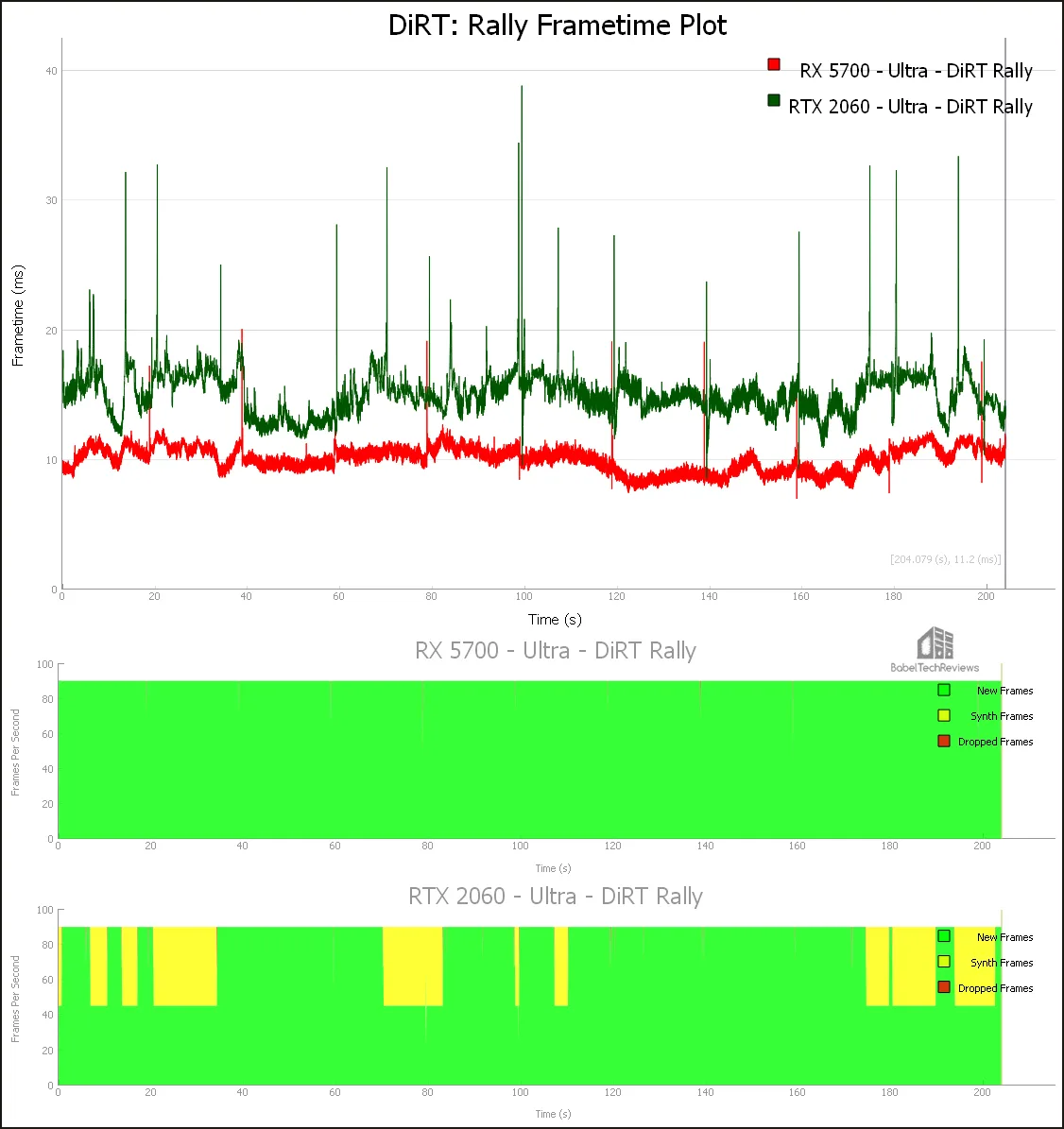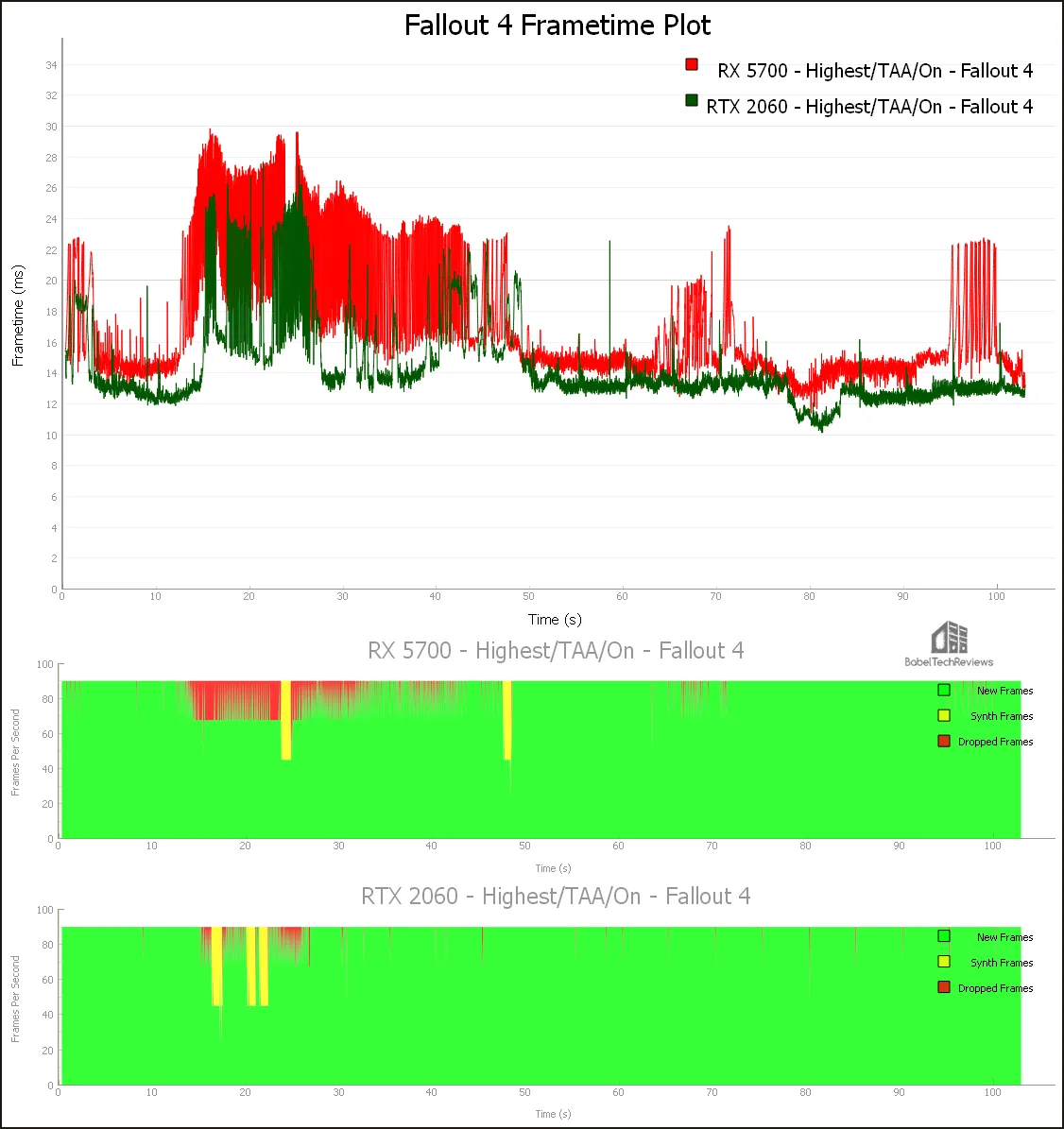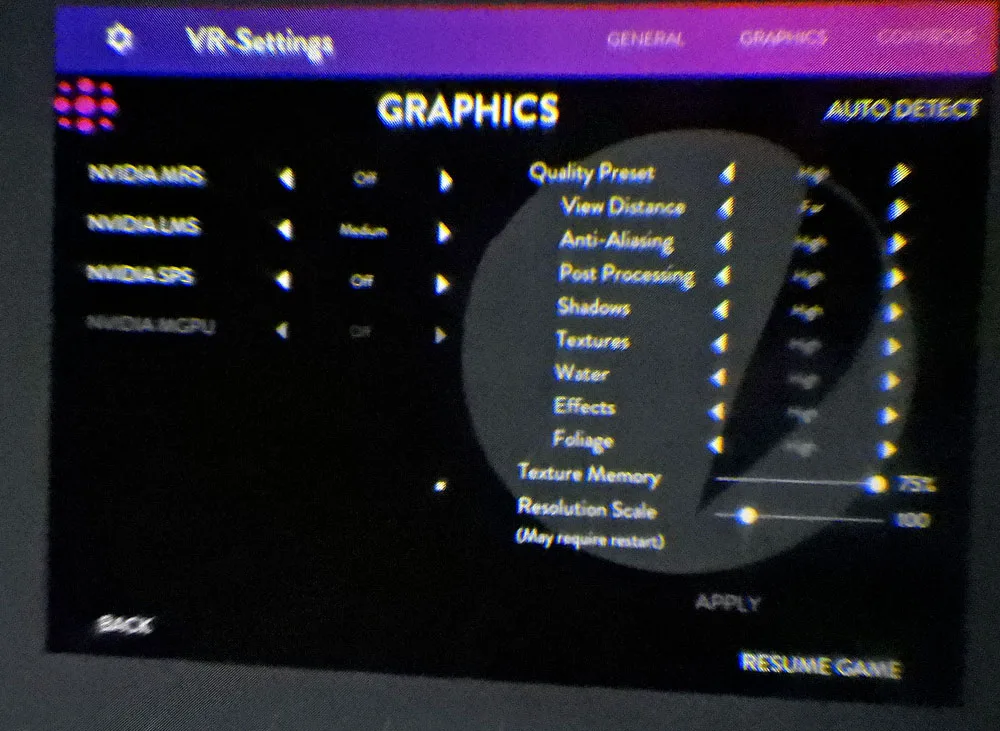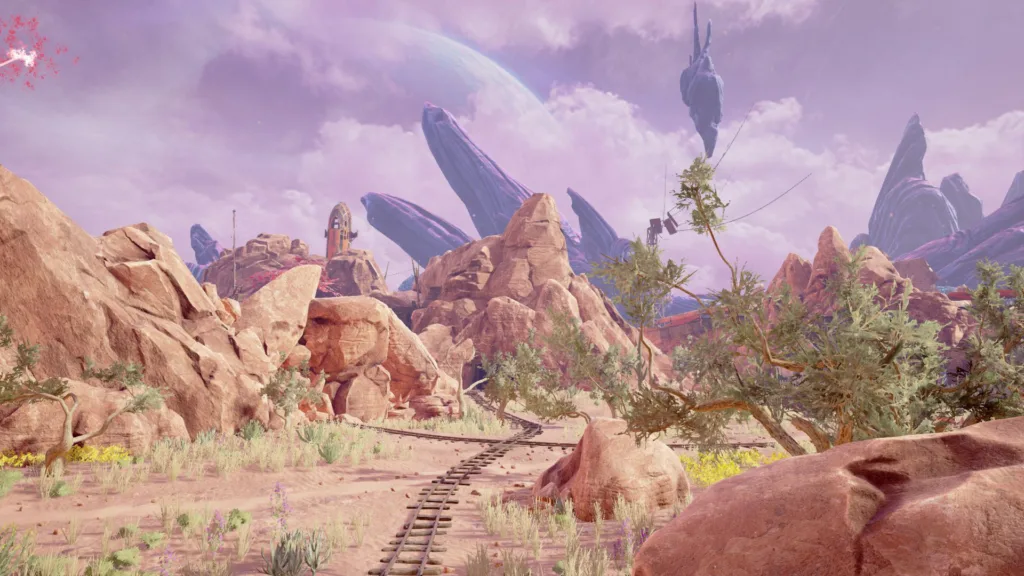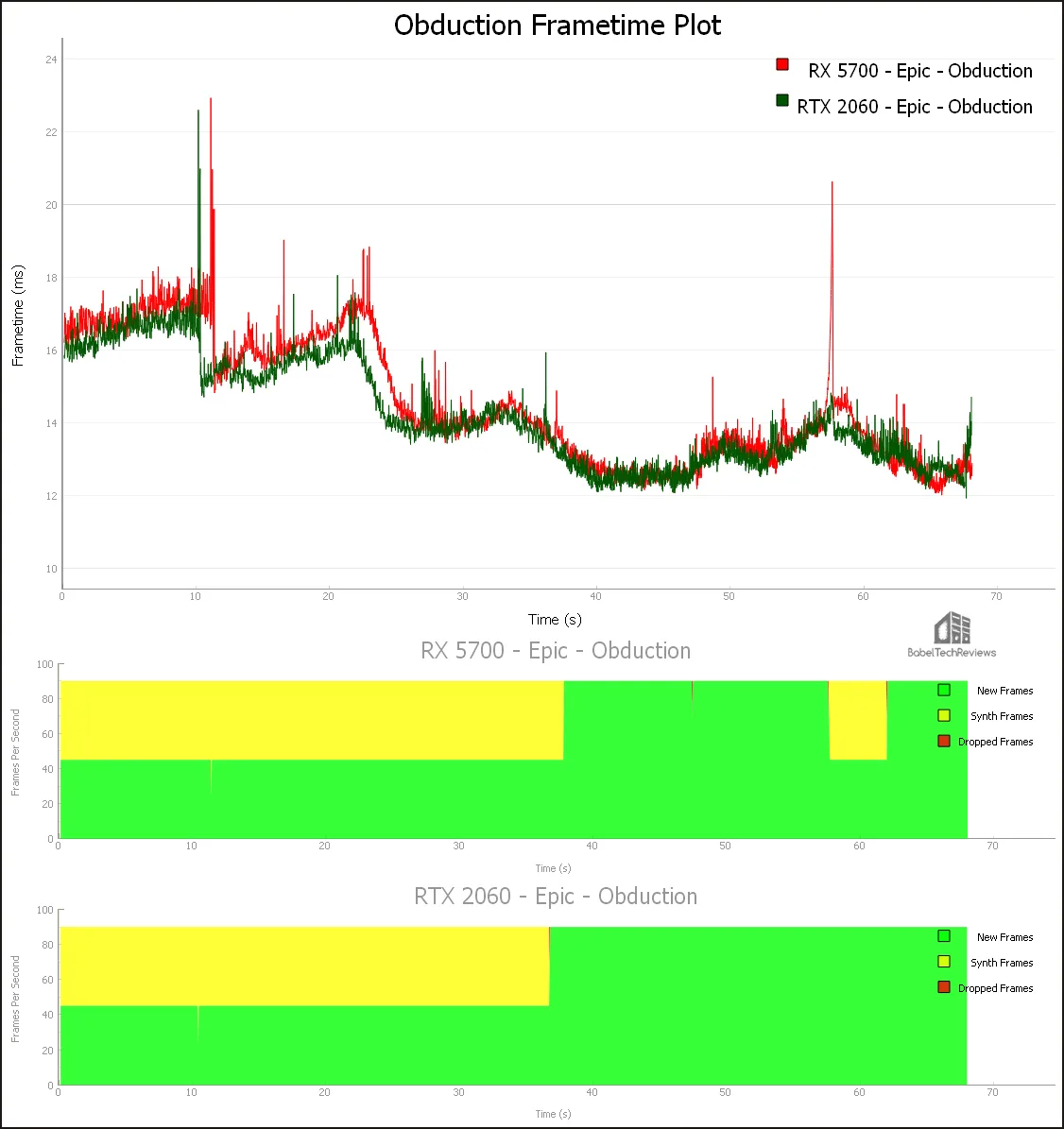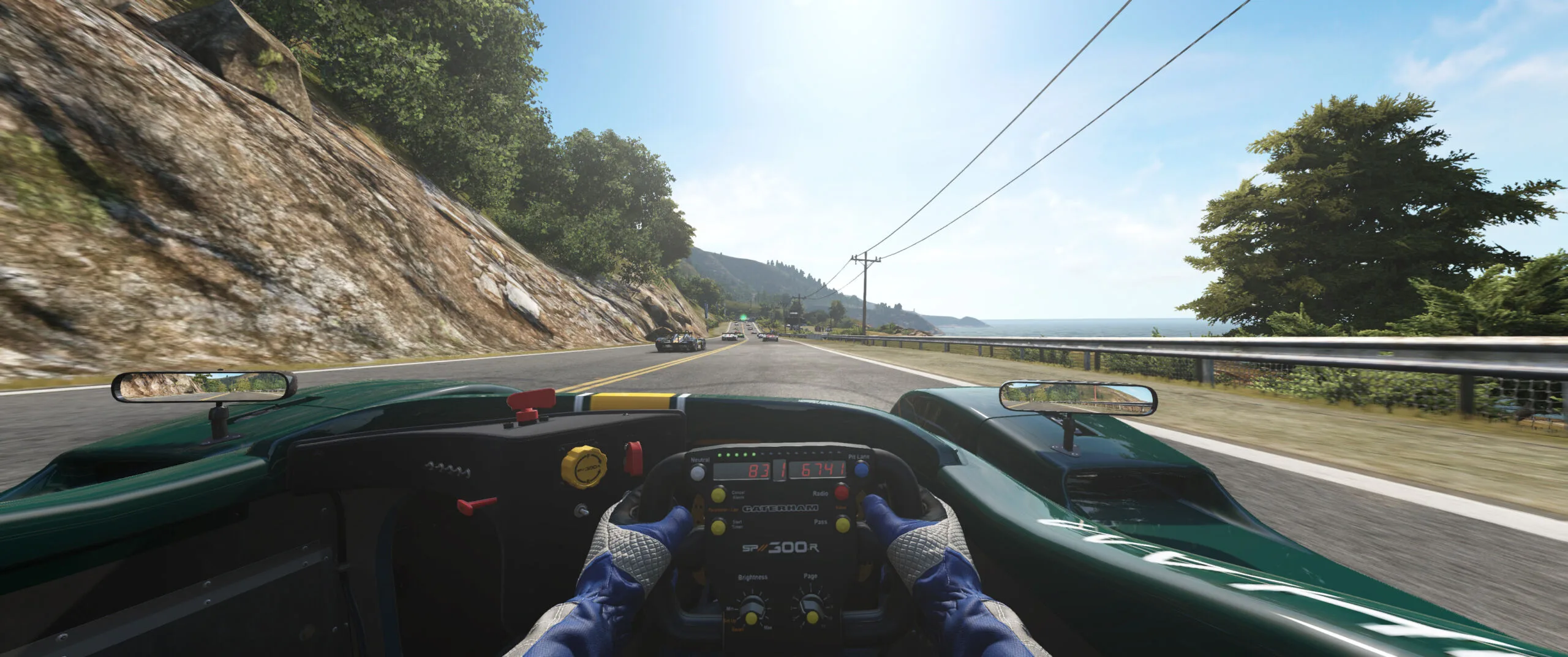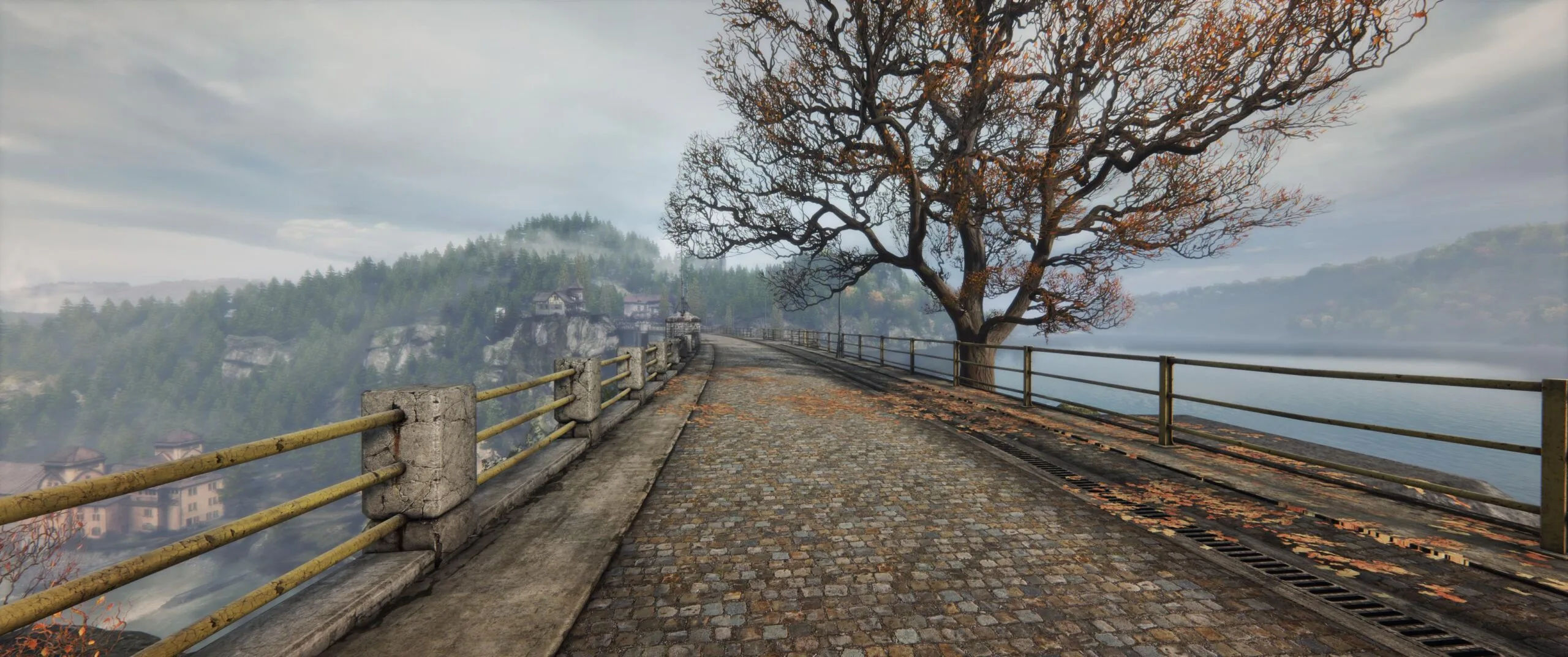VR Wars: The RTX 2060 Founders Edition vs. the Red Devil RX 5700
This is a follow-up to our June VR evaluation where we saw the RTX 2070 move ahead of the GTX 1080 and solidly beat the liquid-cooled RX Vega 64 in VR performance. We now present another eleven-game VR performance face-off between the Navi Red Devil RX 5700 versus the Turing RX 2060 Founders Edition (FE) measuring frametimes and unconstrained performance using FCAT VR.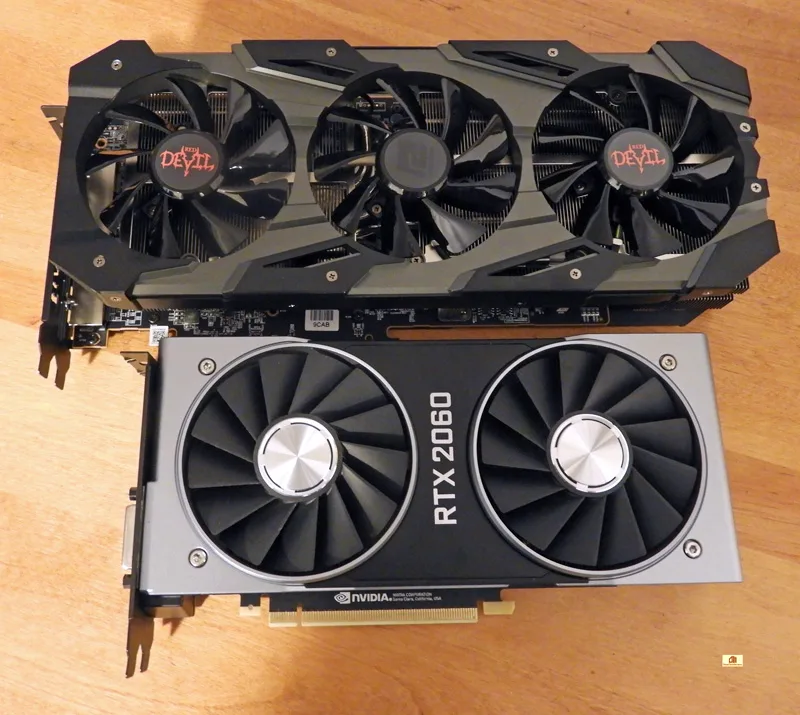
Since we posted our original review over two and one-half years ago, we have benchmarked VR games for our follow-up reviews over the past thirty months. We have also compared FCAT VR with our own video benchmarks using a camera to capture images directly from the Rift’s lens. For BTR’s VR testing methodology, please refer to this evaluation.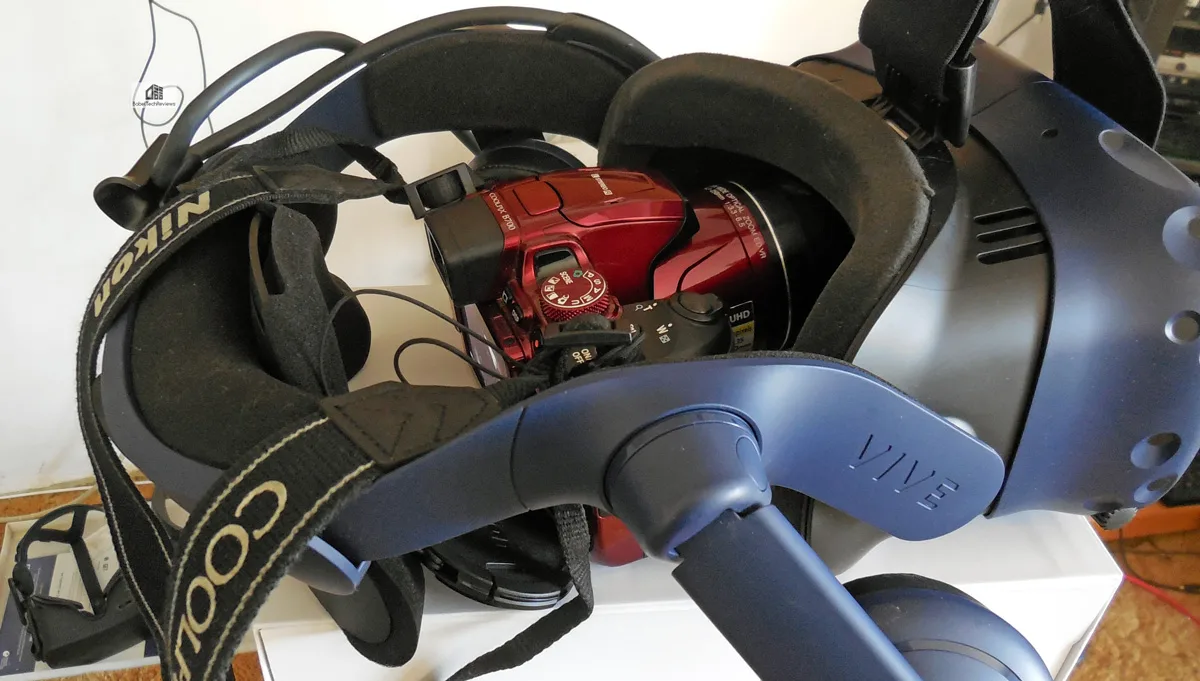
We currently benchmark eleven Oculus Rift VR games at maxed-out settings using the Red Devil RX 5700 versus the RTX 2060 Founders Edition (FE). BTR’s testing platform is an Intel Core i7-8700K at 4.8GHz, an EVGA Z370 FTW motherboard and 16 GB of T-Force XTREEM DDR4 at 3866MHz on Windows 10 64-bit Home Edition. Here are the eleven VR games that we benchmark:
- Batman VR
- Chronos
- DiRT: Rally
- Elite Dangerous
- Fallout 4
- Hellblade: Sennua’s Sacrifice
- Obduction
- Project CARS 2
- Robinson: The Journey
- Skyrim
- The Vanishing of Ethan Carter
It is important to be aware of VR performance since poorly delivered frames will actually make a VR experience quite unpleasant even leading to VR sickness. It is also very important to understand how to accurately benchmark VR as explained here. But before we benchmark our eleven VR games, take a look at our Test Configuration.
Test Configuration – Hardware
- Intel Core i7-8700K (HyperThreading and Turbo boost is on to 4.8 GHz for all cores; Coffee Lake DX11 CPU graphics).
- EVGA Z370 FTW motherboard (Intel Z370 chipset, latest BIOS, PCIe 3.0/3.1 specification, CrossFire/SLI 8x+8x), supplied by EVGA
- T-Force XTREEM 16GB DDR4 (2×8 GB, dual channel at 3866MHz), supplied by Team Group
- RTX 2060 6 GB Founders Edition, stock FE clocks, on loan from NVIDIA
- Red Devil RX 5700, 8GB at Red Devil clocks, on loan from PowerColor
- 2 x 480GB Team Group SSDs – 1 for Radeon and 1 for GeForce
- 1.92 TB San Disk enterprise class SSD
- 2 TB Micron 1100 enterprise class SSD
- Seasonic 850W Gold Focus power supply unit
- EVGA CLC 280mm CPU water cooler, supplied by EVGA
- EVGA Nu Audio stereo PCIe sound card, supplied by EVGA
- Edifier R1280T active desktop speakers
- EVGA DG-77, mid-tower case supplied by EVGA
- Monoprice Crystal Pro 4K
- Oculus Rift CV1
Test Configuration – Software
- Nvidia’s Game Ready 436.15 WHQL drivers.
- Adrenalin Software Edition 19.8.2
- Unconstrained framerate results show average frame rates in bold including dropped and synthetic frames shown on the chart next to the averages in a smaller italics font.
- Highest quality sound (stereo) used in all games.
- Windows 10 64-bit Home edition v1903.
- Latest DirectX
- All 11 VR games are patched to their latest versions at time of publication.
- Precision X1
- Wattman
- FCAT-VR Capture v0.9.3202.0 UAC
- FCAT-VR Beta 17
11 VR Game benchmark suite & 2 synthetic tests
Synthetic
- VRMark Cyan Room
- Unigine Superposition VR Benchmark
Oculus Rift VR Games
- Batman VR
- Chronos
- DiRT: Rally
- Elite Dangerous
- Fallout 4
- Hellblade: Senua’s Sacrifice
- Obduction
- Project CARS 2
- Robinson: The Journey
- Skyrim
- The Vanishing of Ethan Carter
The Unreal 4 engine is one of the two most popular engines for VR development, and five of our games use it. The Creation engine is used for two games, while the Ego, COBRA, Cryengine, and Madness engines are each represented by one game. All of the engines are identified in each of the following game’s descriptions.
Let’s individually look at our eleven VR games’ performance using FCAT-VR plus two synthetic benches. First up, Batman Arkham VR.
Batman Arkham VR
Batman Arkham VR immerses you into Batman’s world without involving fighting. It is a short game using the Unreal Engine with an emphasis on detective work and puzzle solving. Although it is an older title, it has good visuals.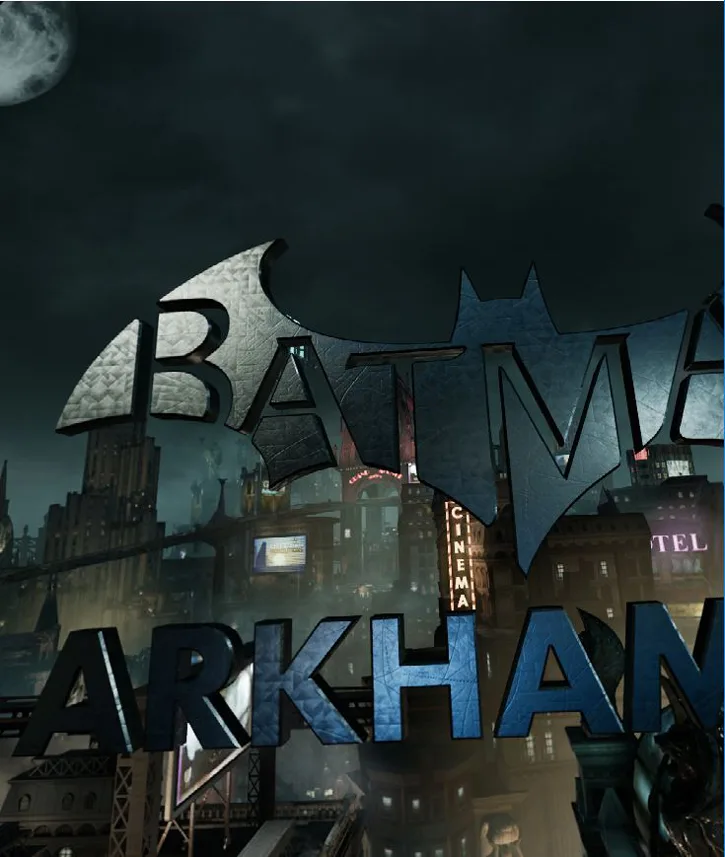
Batman Arkham VR has very few adjustable settings so we benchmark at its full resolution and with 100% pixel density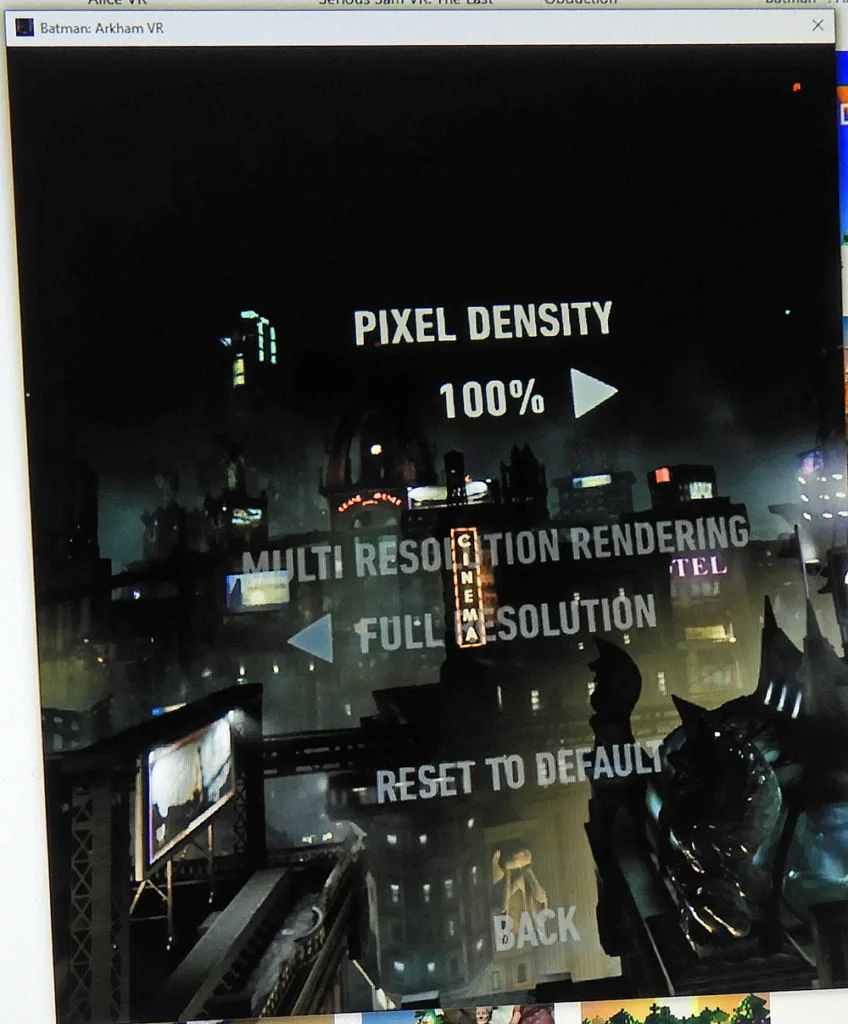
Here are the performance results of our competing cards compared using the FCAT-VR generated chart.
The unconstrained framerate of the RTX 2060 is 163.8 FPS with no dropped frames, and it is slower than the RX 5700 at 178.7 FPS with 12 dropped frames. Neither of our cards have to resort to generating synthetic frames.
Chronos
Chronos is a Rift launch title with graphics options that are good for GPU testing. It is a 3rd-person view RPG which includes many puzzles as well as requiring the player to be good with combat. 
We picked Epic which is the highest settings for each option.

Here is the FCAT-VR generated chart for Chronos.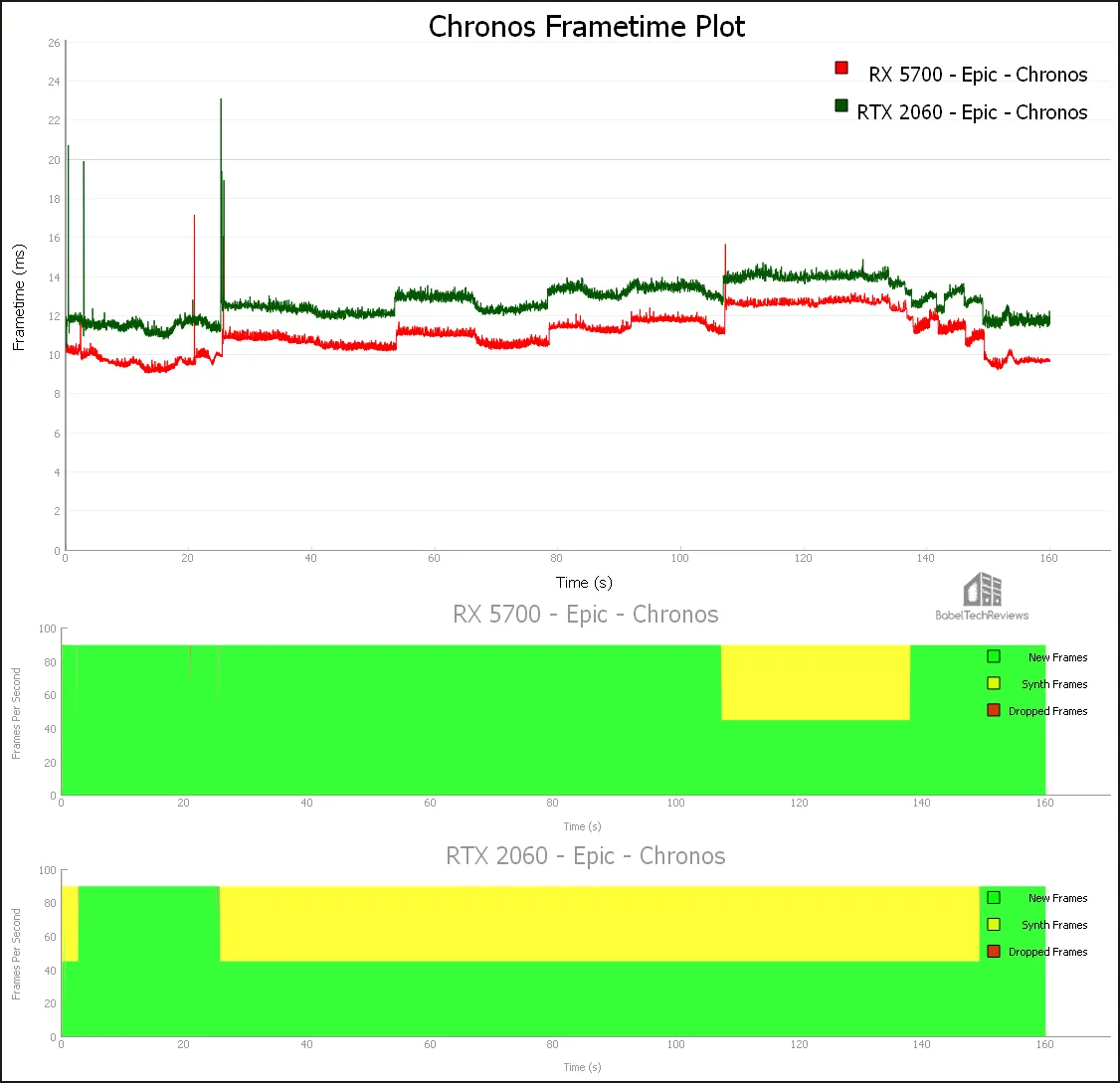 The RTX 2060 manages 79.8 FPS with 4 dropped frames while 39% of its frames are synthesized while the RX 5700 leads with unconstrained 92.1 FPS with 7 dropped frames and 10% synthetic frames. We would recommend lowering setting for each card.
The RTX 2060 manages 79.8 FPS with 4 dropped frames while 39% of its frames are synthesized while the RX 5700 leads with unconstrained 92.1 FPS with 7 dropped frames and 10% synthetic frames. We would recommend lowering setting for each card.
Let’s check out DiRT: Rally next.
DiRT: Rally
DiRT: Rally is built on the Ego Engine. It features a built-in benchmark that is very repeatable. 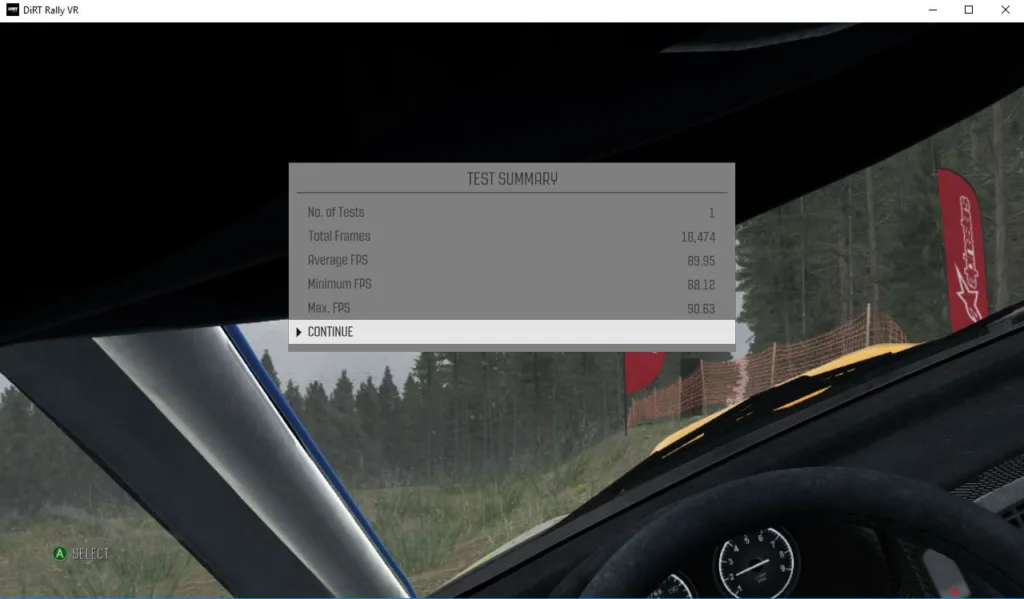 DiRT: Rally is a fun and demanding VR game that requires its players to learn its challenging road conditions. DiRT: Rally has many individual settings although we benchmarked using the stock “Ultra” preset.
DiRT: Rally is a fun and demanding VR game that requires its players to learn its challenging road conditions. DiRT: Rally has many individual settings although we benchmarked using the stock “Ultra” preset.
Here is the DiRT: Rally benchmark run by our 2 test cards as charted by FCAT-VR.
The RTX 2060 manages 67.4 unconstrained frames per second with 41 dropped frames and 15% synthetic frames while the RX 5700 pulls ahead with 100.8 FPS, 16 frames are dropped, and none of its frames are synthetic.
Elite Dangerous
Elite Dangerous is a very popular space sim built using the COBRA engine. It is difficult to find a repeatable and demanding benchmark outside of the training missions.

A player will spend a lot of time piloting a space cruiser while completing a multitude of tasks. Elite Dangerous is also co-op and multiplayer, and you need to be connected to the Internet. It has a very dedicated following of players.
We picked the default Ultra setting and maxed out our FoV. Here are the frametimes.
The RTX 2060 delivers 69.0 unconstrained frames per second with 1 dropped frame edging out the RX 5700 with 67.8 FPS with no dropped frames. For each card, 50% of the frames were synthetically generated.
Let’s check out another demanding game, Fallout 4.
Fallout 4 VR
Fallout 4 uses the Creation Engine. It has been somewhat optimized for the Oculus Rift and the controls work decently with it although we prefer using the Vive. We benchmark at its highest settings and with TAA.
Here is the frametime plot for Fallout 4.
In Fallout 4, the RTX 2060 delivers 69.7 FPS with 104 dropped frames and 10% synthetic frames while the RX 5700 delivered 58.7 unconstrained FPS with 390 dropped frames and also generated 10% synthetic frames.
Next we benchmark Hellblade: Senua’s Sacrifice.
Hellblade: Senua’s Sacrifice
Hellblade: Senua’s Sacrifice is a very impressive game visually using the Unreal 4 engine. It is an very dark and disturbing game that is far more intense in VR than playing the pancake version. We benchmark at Very High settings and with TAA.
Here is the frametime plot for Hellblade: Senua’s Sacrifice.
In Hellblade: Senua’s Sacrifice, the RTX 2060 delivers 93.7 FPS with 29 dropped frames. The RX 5700 does better with 111.8 unconstrained FPS with 17 dropped frames. Neither card needs reprojection.
Next we will check out another very demanding VR game, Obduction.
Obduction
Obduction is an adventure video game developed by Cyan Worlds using the Unreal 4 engine. Obduction is considered the spiritual successor to Myst and Riven. There is an emphasis on puzzle solving which get progressively more difficult as the player progresses.

The RTX 2060 delivers 72.2 FPS with 1 dropped frames but with 27% synthetic frames generated. The RX 5700 delivers 70.8 FPS with 6 dropped frames and 31% of the frames are synthesized.
Next we will check out another demanding VR game, Project CARS 2.
Project CARS 2
One has to experience Project CARS 2 as a player to appreciate it, and there is absolutely no way to convey the incredible sense of immersion that comes from playing it in VR using a wheel and pedals. It uses the in-house Madness engine and its physics implementation is outstanding.
Project CARS 2 offers many performance options and settings, and we prefer playing with SMAA Ultra which seems to offer a bit of temporal anti-aliasing.
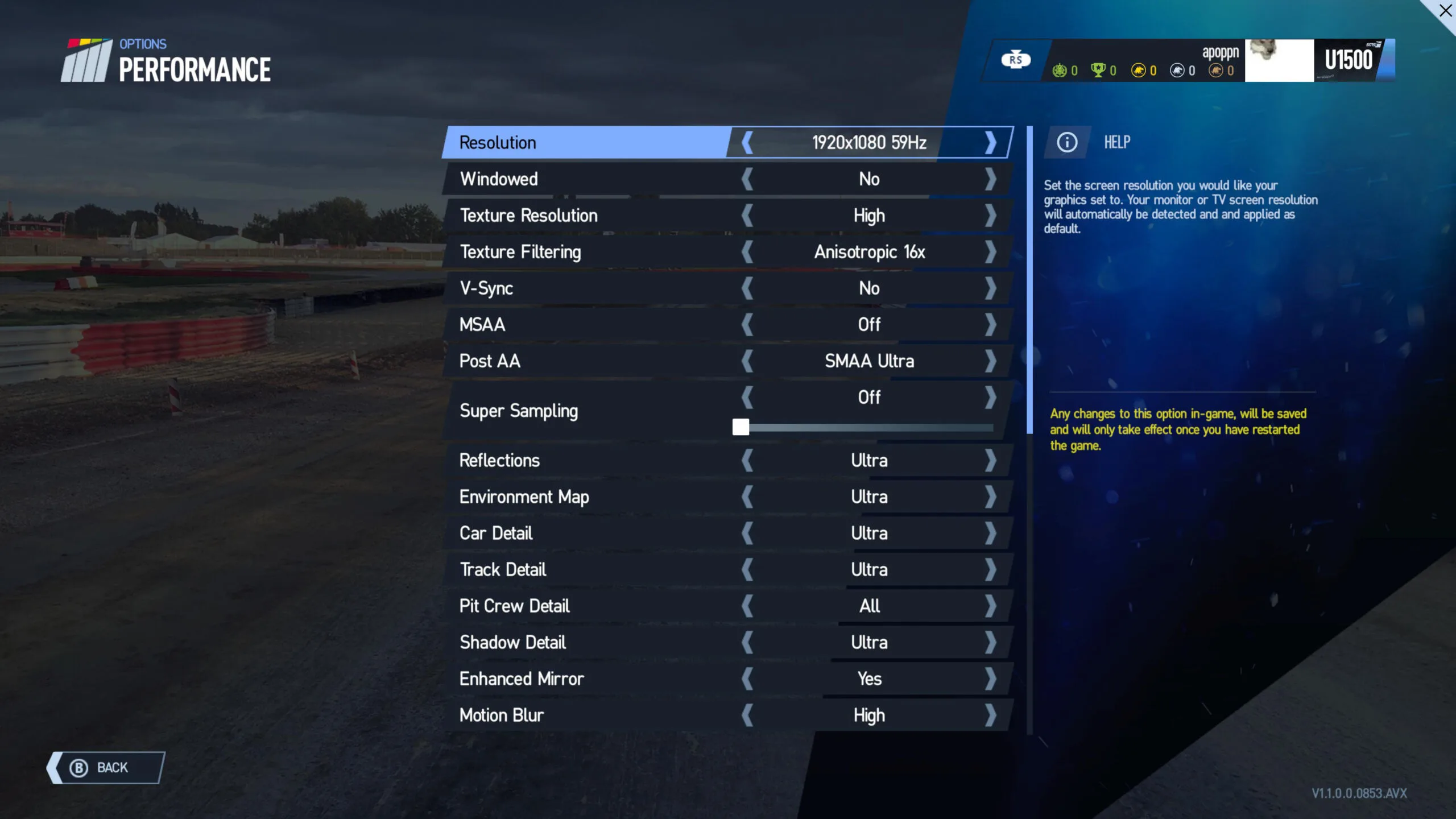
We picked the SMAA Ultra pre-set and we used maximum settings except for Motion Blur which looked best to us on Low. The other setting were set at their highest.
Project CARS 2 makes good use of the Oculus Asynchronous Space Warp (ASW) feature so that a card delivering less than 90 FPS will intelligently reproject every other frame and will still be playable without causing VR sickness. We would also recommend lowering grass and reflections to maximize framerate delivery if necessary.
Here are the results of our FCAT-VR benching.
The RTX 2060 delivers 59.3 unconstrained FPS, no dropped frames and 50% synthetic frames generated, while the RX 5700 delivers 64.5 FPS with 3 dropped frames and 45% of its frames are synthesized.
Let’s benchmark Robinson: The Journey.
Robinson: The Journey
Robinson: The Journey is first person adventure/puzzle game developed by Crytek using the Cryengine. Just like with Crytek’s PC games, the visuals are among the very best to be found in any VR game.
For us, Crytek’s Robinson: The Journey was a blast to play in VR with a start to finish in about 6 hours. It’s probably Crytek’s best story and you even get a pet baby T-Rex.
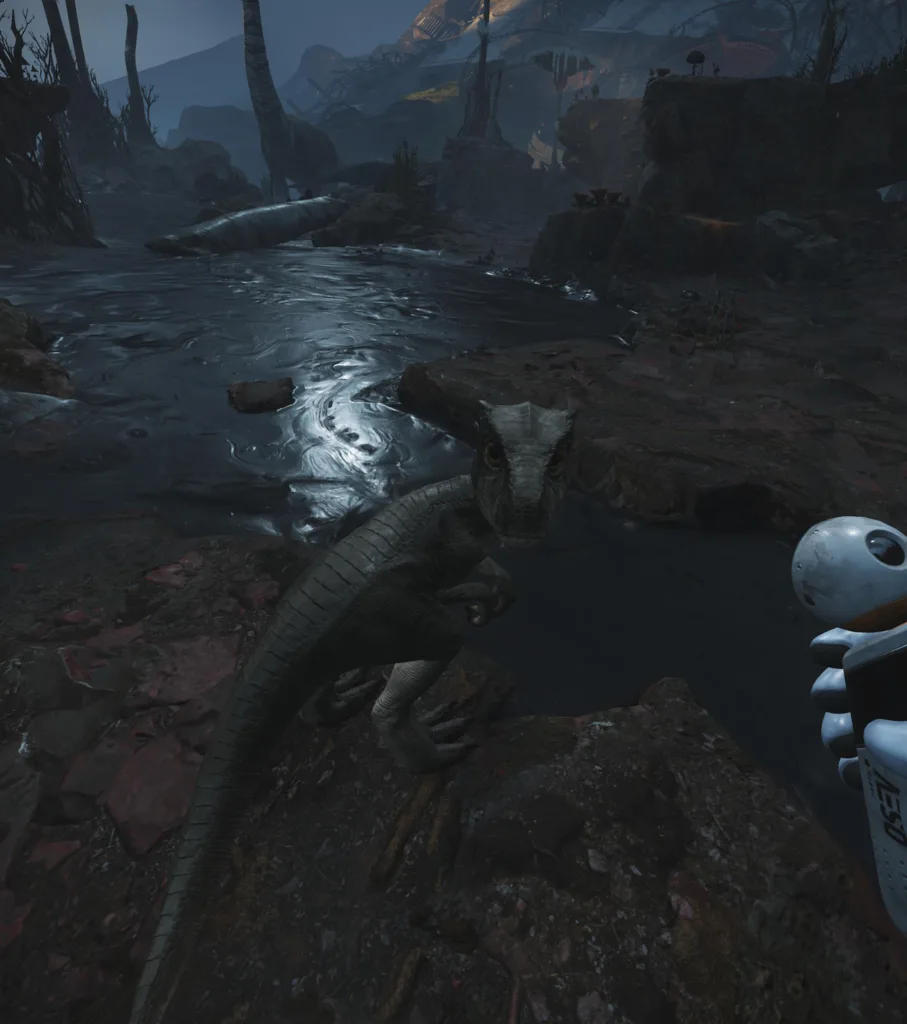
We benchmarked at the highest settings as below but used 1.0X as the resolution setting.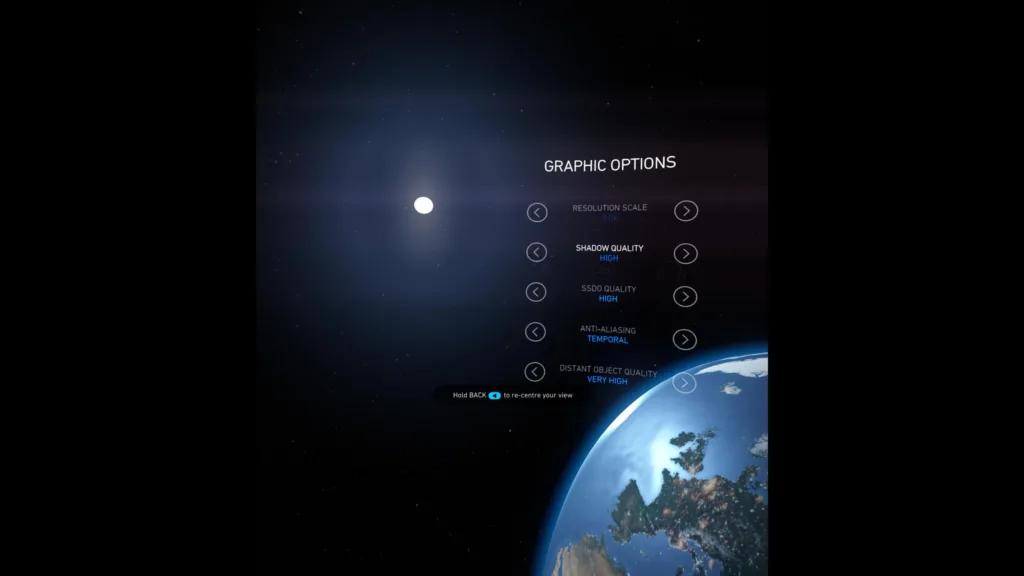
Here is the frametime plot of our competing two video cards: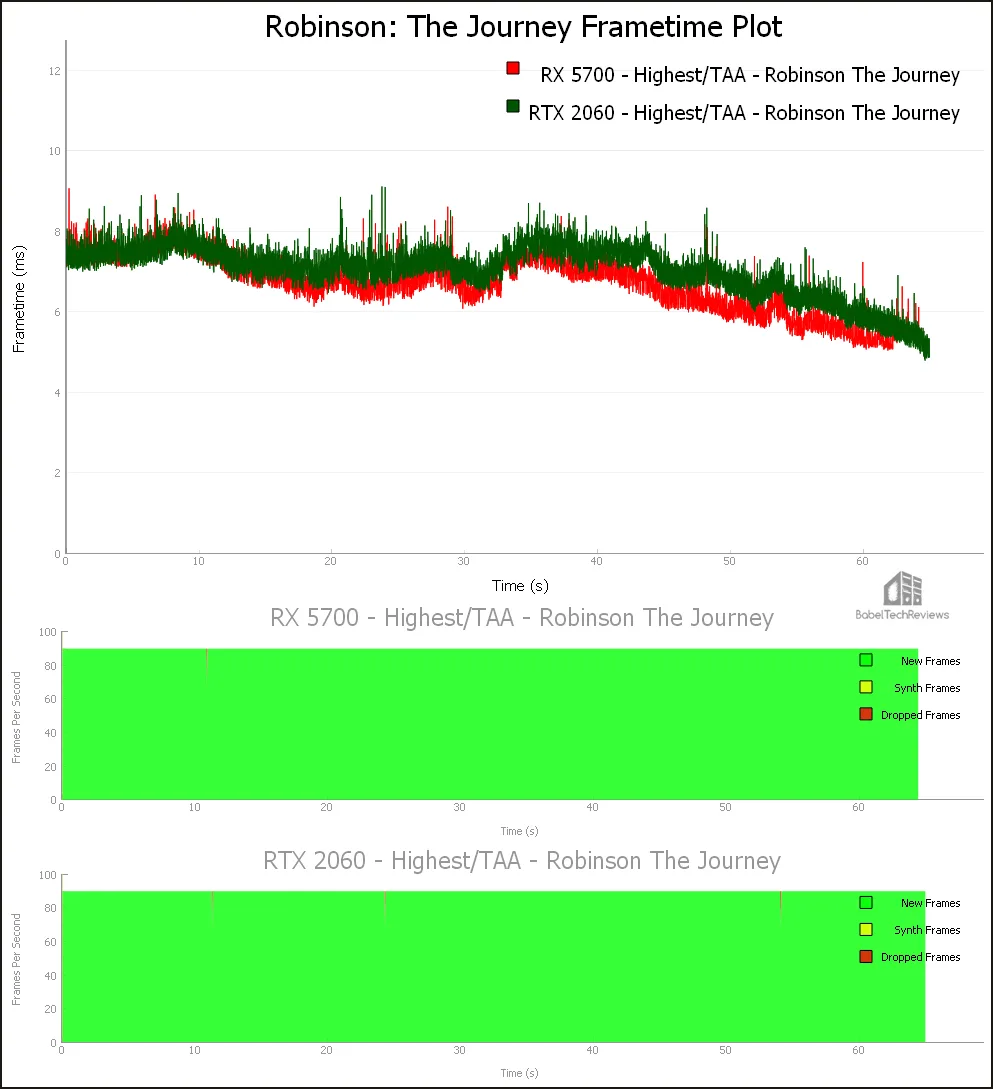
The RTX 2060 delivers 141.9 FPS with 3 dropped frames. The RX 5700 delivers 149.3 FPS with 1 dropped frame. No synthetic frames were needed to be generated by our cards.
Let’s benchmark Skyrim VR.
Skyrim VR
Skyrim VR is an older game that is not as demanding as many of the newer VR games so its performance is still very good on maxed-out settings using its Creation engine.
We benchmarked Skyrim VR using its highest settings, but we left the resolution at 100%.
The RTX 2060 delivers 114.8 unconstrained frames per second with 10 dropped frames, while the RX 5700 delivered 95.6 FPS with 9 dropped frames. No synthetic frames were needed to be generated by either card.
The Vanishing of Ethan Carter
The Vanishing of Ethan Carter is built on the Unreal 4 engine and it boasts amazing visuals. It is considered by some to be a “walking simulator”, but it is also an excellent detective game with great puzzles. Beware as its locomotion tends to make many players VR sick.
There are just a few in-game graphics options available, so we picked 100% resolution with TAA.
The RTX 2060 delivered 146.6 FPS with 8 dropped frames. The RX 5700 delivers 141.0 FPS with 7 dropped frames. No synthetic frames were needed to be generated.
If there is performance headroom, we recommend increasing the resolution multiplier as far as a player’s card can handle without the need to generate synthetic frames. The Vanishing of Ethan Carter is the last of our eleven tested games, so let’s look at the summary charts.
Unconstrained FPS, dropped frames, and synthetic frames
In this chart, we summarize the overall Unconstrained Framerates summing up our eleven test games. This time we also show the RX Vega 64, the GTX 1080, and the RTX 2070 on recent drivers for comparison. The Unconstrained Framerate is given by bold text, followed by the dropped frames (d), and the percentage of synthetic frames (s) in italics.
Let’s check out our conclusion.
Conclusion
The RX 5700 and the RTX 2060 are in approximately the same class when it comes to VR performance. The RX 5700 delivers higher unconstrained frames in six games while the RTX 2060 is faster in five games out of the eleven VR games we benchmarked.
Although the RX Vega 64 liquid-cooled edition is in the same class as the GTX 1080 and the RTX 2070, it falls far behind both of these cards in VR performance and it is also beaten by the RX 5700 in all but two games. We can conclude that Navi is better suited for VR than Vega.
We will continue our VR benchmarking as we transition from benchmarking with the Oculus Rift to benchmarking with the Vive Pro. The Pro is more demanding of video cards with better visuals and a higher resolution than the Rift.
Our upcoming review will introduce Vive Pro benchmarking in addition to using the Oculus Rift as we continue our “VR Wars” series by comparing the RTX 2060 SUPER FE and the RTX 2070 SUPER FE versus the 50th Anniversary Edition of the RX 5700 XT. Stay tuned!
Happy VR gaming!

